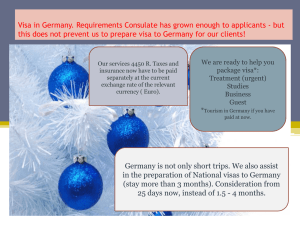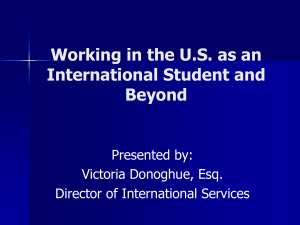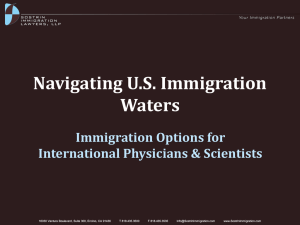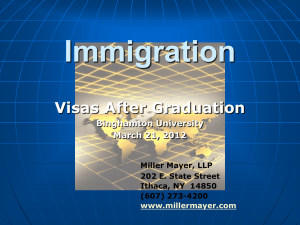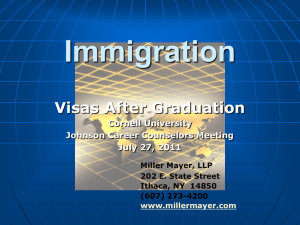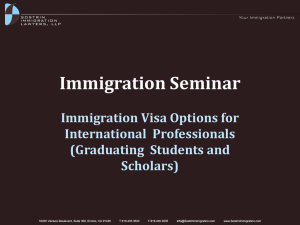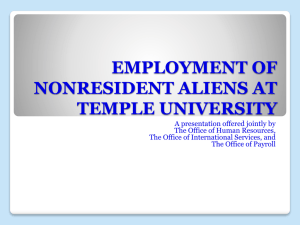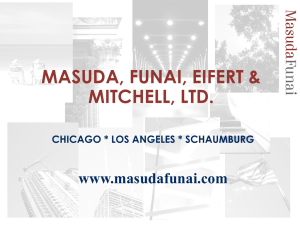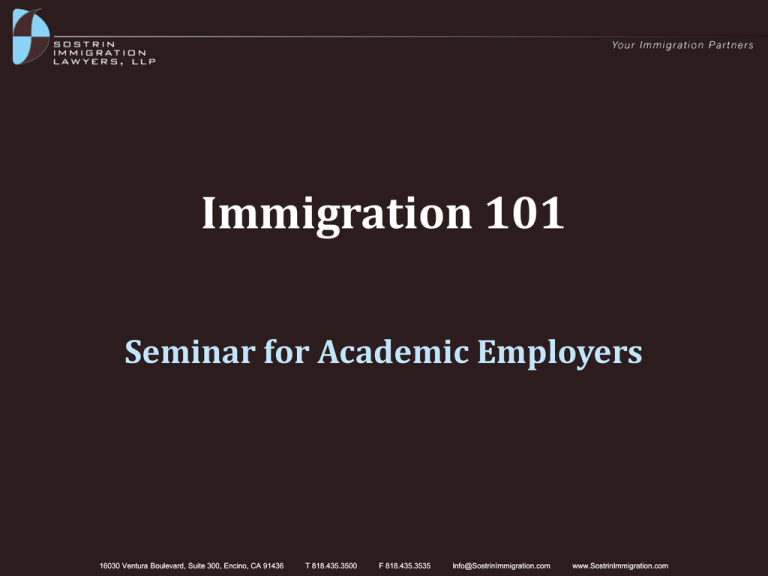
Immigration 101
Seminar for Academic Employers
16030 Ventura Boulevard, Suite 300, Encino, CA 91436
T 818.435.3500
F 818.435.3535
Info@SostrinImmigration.com
www.SostrinImmigration.com
Overview
•
•
•
•
•
•
Nonimmigrant work visas
J-1 waivers
Permanent residence options
Hiring strategies
Immigration planning strategies
Q&A
Overview
• All non-U.S. citizens and non-permanent
residents require a visa to enter the U.S.
• Employer may sponsor an employee for
nonimmigrant visa to authorize work
• Nonimmigrant visas are valid for temporary
period
• Employer may sponsor an employee for
permanent residence (“green card”)
Nonimmigrant Visas (J-1)
• J-1 Exchange Visitor Visa:
– Issued by employing institution (no attorney
needed)
– Many physicians perform GME in J-1 status
– May last up to 7 years, depending on program
– All physicians who do GME in J-1 status are
subject to 2-year home residence requirement
• Spouse/children: J-2 visa (spouse may apply
for work authorization)
Nonimmigrant Visas (J-1)
• Being subject to 2-year home residence
requirement means that J-1 holder:
• Must return home for 2 years before eligible for
H or L visas, or permanent residence
• May not change status in the U.S.
• May be eligible for other visas (J-2, O-1, TN, F-1,
E-3) by applying abroad
Nonimmigrant Visas (J-1)
• J-1 holder may be subject to 2-year
requirement because of:
– Skills List (available at
http://travel.state.gov/visa/temp/types/types_
4514.html)
– Government funding (U.S. or home country)
– Graduate medical training (medical residency
or fellowship)
Nonimmigrant Visas (J-1)
• If “subject,” J-1 holder may:
– Fulfill 2-year requirement in home country
(country of citizenship or last permanent
residence);
– Obtain another nonimmigrant status and stay in
the U.S. (note: 2-year requirement will still
apply); or
– Obtain a waiver of 2-year requirement
J-1 Waiver
• Waivers of 2-year requirement:
– No-Objection Waiver (not available if “subject”
because of GME)
– Interested Government Agency Waiver (e.g., State
Health Department, HHS, NSF, DOE, DOD, etc.)
– Hardship Waiver
– Persecution Waiver
• Special considerations for Fulbright scholars
J-1 Waiver
• Interested Government Agency Waiver:
– Any state or federal agency may serve as IGA
– Examples of agencies: State Departments of Health,
Veterans Administration, Department of Health &
Human Services, National Science Foundation,
Department of Energy, Department of Defense
– Each agency has specific requirements
– Waiver application must be sponsored by employer
– Applicant must serve interests of the agency (show
funding or other public interest)
Conrad State 30 Waiver
• IGA for UAMS physicians: AR Department of Health
(Conrad State 30 program)
• Waiver must be sponsored by an employer
• Employment must be located in:
– Health Professional Shortage Area (HPSA) or Medically
Underserved Area (MUA)
– Areas outside of HPSA/MUA that serve underserved
populations: at least 30% of applicant’s patients must reside
in underserved areas
• Employment contract cannot have non-compete clause
• Employment in underserved area must be for 3 years
Conrad State 30 Waiver
• To qualify for a waiver, physician must:
– Have completed a U.S. residency training program
– Provide primary care medical services (defined as
Family Medicine, Pediatrics, OB/GYN, IM) or general
psychiatry services
– Provide specialty medical services if there is a
shortage of specialists
– Commit to work at least 40 hours per week for three
(3) years in the designated underserved area
Conrad State 30 Waiver
• To qualify for a waiver, employer must:
– Have a legitimate need for physician’s services
– Show that another suitable candidate could not
be found (i.e., demonstrate recruitment efforts)
– Show that physician will provide critically
needed medical services to an underserved area
or patients who come from underserved areas
(patient origin study is required if facility is not
located in designated underserved area)
Conrad State 30 Waiver
• Physician must complete 3-year commitment with
the sponsoring employer in H-1B status
• If does not complete 3 years, waiver may be
revoked
• May start permanent residence process during the
3-year commitment, but may not finish it until 3
years are completed
• No transfers unless extenuating unforeseeable
circumstances beyond physician’s control
Conrad State 30 Waiver
• Fiscal year starts on October 1
• Only up to 30 waivers per year
• State Department of Health may run out of waivers
before fiscal year ends
• Consider recruiting early to file waiver application on
October 1
• UAMS is not in a designated area – patient origin study
is required
• Keep confirmation of all recruitment efforts
J-1 Waiver
• Processing periods:
– No-Objection/IGA/Hardship/Persec. (1 – 6 mos.)
– DOS (4 – 6 weeks)
– USCIS (4 – 6 weeks)
• Filing fee:
– DOS case number: $215
– Some agencies/Embassies charge additional fee
Nonimmigrant Visas (H-1B)
• H-1B Specialty Occupation Visa requirements:
– Must hold bachelor’s degree or equivalent in a specific
specialty (e.g., Biology, Chemistry, Mathematics, etc.)
– Job must require at least bachelor’s degree in
specialized field
• “Specialty occupation” – requires theoretical
and practical application of a body of
specialized knowledge and attainment of a
bachelor’s or higher degree in the specific
specialty as a minimum for entry into the
occupation
Nonimmigrant Visas (H-1B)
• H-1Bs for IMG clinicians:
– Must have all steps of USMLE (1, 2CK, 2CS & 3)
– Must hold licensure in AR
• Exceptions from USMLE requirement:
– U.S. MG: foreign national physician who
graduated from U.S. medical school
– Physician of national or international renown
Nonimmigrant Visas (H-1B)
• H-1B filing process:
– Determine prevailing wage
– Employer must file Labor Condition Application
to confirm that will pay required wages
– File H-1B petition with USCIS
– Petition must contain: certified LCA, I-129
forms, support letter, employee’s qualifications,
information about employer, filing fees
Nonimmigrant Visas (H-1B)
• There is an annual cap of 65,000
• Employers not subject to H-1B cap:
– Institutions of higher education (universities,
colleges, other entities granting degrees);
– Non-profit organizations affiliated with institutions
of higher education (must have affiliation
agreement)
– Non-profit research organizations
– Government research organizations
Nonimmigrant Visas (H-1B)
• Validity period of H-1B visa:
– 3 years, plus 3-year extension (total 6 years)
– May extend beyond 6-year maximum if:
• Green card started more than 1 year before H-1B
expiration (will get 1-year extensions)
• Immigrant visa (I-140) approved, but employee may
not file adjustment application (I-485) because
subject to visa retrogression (will get 3-year
extensions)
• Spouse/children: H-4 visa (no work
authorization)
Nonimmigrant Visas (H-1B)
• Employer’s responsibilities:
– Pay all H-1B expenses
– Pay required wage
– Offer same benefits as to U.S. workers
– Attest that no strike at workplace
– Maintain Public Access File
– If H-1B worker terminated, must pay for return
transportation home (if worker returns home)
Nonimmigrant Visas (H-1B)
• Termination of an H-1B worker:
– Must obey all employment laws
– Pay for return transportation costs to the home
country
– If employee decides to leave employment, no
need to pay for transportation costs
– Withdraw the H-1B petition (i.e., notify USCIS)
Nonimmigrant Visas (H-1B)
• H-1B USCIS filing fees:
– Standard fee: $325
– Fraud prevention and detection fee: $500 (only
with initial filing)
– Training fee (only for cap-subject employers for
initial filing and first extension):
• $1,500 for employers with 26 or more employees
• $750 for employers with 25 or fewer employees
– Premium processing fee (optional): $1,225
Nonimmigrant Visas (H-1B)
• H-1B hiring strategies:
– If hiring an employee who holds H-1B status,
check immigration documentation
– Make advance plans to avoid reaching the 6year limit of H-1B status
– Consider other nonimmigrant visas as
alternatives if running out of H-1B status
– For physicians: check USMLEs and licensure
Nonimmigrant Visas (H-1B)
• If reach 6-year maximum limit:
– Recapture time spent abroad (keep travel
records);
– Extend H-1B beyond 6 years (if green card filed)
– Qualify for another non-immigrant status
– Go abroad for 1 year (re-starts 6-year clock)
• Because of 6-year maximum, must start
long-term planning early (no later than in
5th year)
Nonimmigrant Visas (E-3)
• E-3 Treaty Visa requirements:
–
–
–
–
–
–
Beneficiary must be Australian citizen
Specialty occupation visa (similar to H-1B)
Not subject to annual cap
Valid for 2 years with indefinite extensions
May apply at Consulate
If filed with USCIS, filing fee: $325 (no premium
processing)
• Spouse/children: E-3 Dependent visa (may
apply for work authorization)
Nonimmigrant Visas (TN)
• TN (Trade NAFTA) Visa requirements:
– Applicant must be citizen of Canada or Mexico
– Profession is on NAFTA list (www.nafta-secalena.org/en/view.aspx?x=343&mtpiID=147#A
p1603.D.1)
– Position requires NAFTA professional
– Applicant will work full-time or part-time for
U.S. employer (self-employment not permitted)
– Applicant has required qualifications
Nonimmigrant Visas (TN)
• TN visa valid for 3 years (may be extended indefinitely)
• Applicant must maintain nonimmigrant intent
• Canadians may apply at border or file petition with
USCIS
• Mexicans must apply at consulate
• Extensions may be filed with USCIS
• Spouse/children: TD visa (no work authorization)
• TN USCIS filing fee: $325 (premium processing
available)
Nonimmigrant Visas (O-1)
• O-1 Extraordinary Ability Visa
requirements:
– Must demonstrate “sustained national or
international acclaim and recognition for
achievements”
– Must show that has risen to the top of the field
• Spouse/children: O-3 visa (no work
authorization)
Nonimmigrant Visas (O-1)
• How to demonstrate “sustained acclaim:”
– Evidence of a one-time achievement (a major,
internationally recognized award); or
– Evidence of at least 3 regulatory criteria
• Valid for 3 years, with 1-year extensions
• May extend O-1 visa indefinitely
• O-1 USCIS filing fee: $325 (premium
processing available)
Nonimmigrant Visas (O-1)
• Must meet at least 3 of the following criteria:
– National or international awards
– Membership in associations in the field that require
outstanding achievements
– Published material about beneficiary
– Participation as a judge of the work of others
– Original scientific or scholarly contributions of major
significance
– Authorship of scholarly articles in professional journals
– Employment in a critical/essential capacity for
organizations with distinguished reputation
– High salary or remuneration for services
Nonimmigrant Visas (O-1)
• Suggested evidence in support of petition:
– Confirmation of achievements (publications,
presentations, peer-review or editorial duties,
awards, memberships, etc.)
– Reference letters (7-8) from experts in the field
– Press about beneficiary or his/her work
• Present as much evidence as possible to meet
more than 3 criteria
• O-1 visa may be stepping stone for green card
Immigrant Visas
• Immigrant visa is path to permanent
residence (two- or three-step process)
• Options depend on job, employee’s
qualifications, employer’s involvement
• Each case is analyzed individually to
determine the best strategy
Immigrant Visas (PERM)
• PERM Labor Certification process:
– Test of local labor market for available U.S.
workers, able, willing and qualified for the job
– Recruitment conducted before applying to DOL
– If no able, willing and qualified U.S. workers,
DOL will certify PERM application
– If U.S. worker applies for the job and meets the
minimum requirements, application may be
denied
Immigrant Visas (PERM)
• Employer’s responsibilities:
– Establish minimum requirements (educational,
training, experiential) for the job
– Recruit for a minimally qualified U.S. worker
– Offer to pay prevailing wage
– Pay legal fees and recruitment costs
• Employee may not participate in
recruitment
Immigrant Visas (PERM)
• All recruitment must be done 30-180 days
prior to filing with DOL
• All potentially qualified U.S. applicants must be
interviewed to determine whether qualified
• U.S. applicants: U.S. citizens, permanent
residents, refugees or asylees
• Non-U.S. applicants do not have to be
considered
Immigrant Visas (Special
Recruitment PERM)
• Special Recruitment PERM requirements:
– Available to university/college teachers only
– Definition of “teaching” has changed (more
lenient)
– Must file PERM within 18 months of selection
for the job
– Job must be advertised in national journal (one
print ad or 30-day online ad)
Immigrant Visas (Special
Recruitment PERM)
• Historically, Special Recruitment was available
only to classroom teachers
• Now, all positions where there is a teaching
component qualify (Matter of Mercer University,
(BALCA Case No. 2011-PER-00162)
• Teaching in less traditional settings (i.e., teaching
of residents, fellows, nurses, etc.) qualifies
• Any amount of teaching will suffice
Immigrant Visas (Special
Recruitment PERM)
• Recruitment must include:
– One (1) national professional journal print ad
(e.g., JAMA); or
– 30 calendar day ad posting in an electronic or
web-based national professional journal;
– The online ad posting must stem from (or be
accessible from) an actual journal site, not a
national association’s online career portal
Immigrant Visas (Special
Recruitment PERM)
• DOL will certify application if:
– University conducted competitive recruitment
and selection process; and
– Foreign worker is more qualified than any U.S.
worker who applied for the job
• Employer must post notice for 10 days or
provide to CBU
• Employer must pay prevailing wage
Immigrant Visas (Special
Recruitment PERM)
• Timing considerations:
– PERM Special Recruitment application must be
filed within 18 months of selection for the job
(i.e., the date of the offer letter)
– Start permanent residence sponsorship/filing
process no later than 12 months after hire
– If more than 18 months since selection, can
engage in re-recruitment/selection process to
meet the 18-month deadline
Immigrant Visas (PERM)
• Recruitment for professional positions:
– Two print ads in Sunday paper (may post ad in
professional journal instead of 1 Sunday ad)
– 30-day job order with State Workforce Agency
– Three additional venues from DOL list
• Employer must post notice for 10 days or provide
to CBA
• Must show that could not find “minimally
qualified” U.S. worker
Immigrant Visas (PERM)
• Must utilize 3 additional venues:
–
–
–
–
–
–
–
–
–
–
Job fairs
Employer’s website
Job search website other than the employer’s
On-campus recruiting
Trade or professional organizations
Private employment firms
Employee referral program with incentives
Campus placement offices
Local or ethnic newspapers
Radio and television advertising
Immigrant Visas (PERM and
Special Recruitment PERM)
• After PERM approved, may file immigrant
visa petition (I-140)
• Employer must show ability to pay worker’s
wage (annual report, audited financial
statements, or confirmation letter)
• Employee must meet job requirements
(education, training, experience)
Immigrant Visas (PERM and
Special Recruitment PERM)
• If no visa retrogression, beneficiary may file
Adjustment of Status Application (I-485)
• Visa retrogression:
– Backlog in immigrant visa availability for
certain categories (EB-3 for all countries; EB-2
for China and India)
– Not eligible to file I-485 until priority date (PD)
becomes current
– PD established when PERM filed
Immigrant Visas (PERM and
Special Recruitment PERM)
• Filing fees:
– PERM: no fee
– I-140: $580 (premium processing available)
– I-485: $1,070 per applicant (premium processing
not available)
• Processing periods:
– PERM: 6-8 months if no audit
– I-140: 6-9 months (15 days if premium)
– I-485: 6-9 months if no security check delays
Immigrant Visas (EB-12)
• Outstanding Professor or Researcher
Immigrant Visa requirements:
– Available to professors or researchers only
– Must be sponsored by an employer (no selfsponsorship)
– Must demonstrate international recognition as
outstanding in the field
– Must have at least 3 years of teaching/research
experience
Immigrant Visas (EB-12)
• Must meet at least 2 regulatory criteria:
– Major prizes or awards for outstanding
achievement
– Membership in professional associations that
require outstanding achievements
– Published material about beneficiary’s work
– Participation as a judge of the work of others
– Original scientific or scholarly contributions
– Authorship of scholarly books or articles
Immigrant Visas
• USCIS filing fees:
– I-140: $580 (premium processing available)
– I-485: $1,070 per applicant (premium
processing not available)
• Processing periods:
– I-140: 6-9 months (15 days if premium)
– I-485: 6-9 months if no security check delays
Hiring Strategies
• Ask appropriate questions regarding authorization to
work in the U.S.
• Discuss sponsorship and payment policies
• Review immigration options upfront to ensure
successful planning
• Run recruitment campaigns that can be used for J-1
waivers and PERM
• Offer sponsorship as a benefit of long-term commitment
• Consult with immigration counsel prior to placing ads
and prior to hire
Thank you for attending
Questions?
© by Sostrin Immigration Lawyers, LLP. All rights reserved
Presenter
• Rita Sostrin (rsostrin@sostrinimmigration.com) is a partner
of Sostrin Immigration Lawyers, LLP. Ms. Sostrin focuses her
practice on immigration of international physicians and
scientists of extraordinary ability. Throughout her professional
career, Ms. Sostrin has represented a diverse array of clients
across the United States, handling all aspects of employmentbased immigration for employers in various industries including
academia, medical, high-tech and entertainment. She frequently
receives invitations to speak at national and regional
conferences and to write for legal publications. Ms. Sostrin is
included in The International Who’s Who of Corporate
Immigration Lawyers, Chambers USA, and Best Lawyers in
America.

